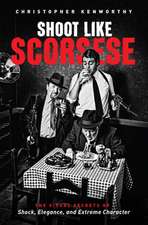Animating Culture: Hollywood Cartoons from the Sound Era: Communications, Media, and Culture Series
Autor Eric Smoodinen Limba Engleză Paperback – mai 1993
Long considered "children's entertainment" by audiences and popular media, Hollywood animation has received little serious attention. Eric Smoodin's Animating Culture is the first and only book to thoroughly analyze the animated short film.
Usually running about seven or eight minutes, cartoons were made by major Hollywood studios––such as MGM, Warner Bros., and Disney––and shown at movie theaters along with a newsreel and a feature-length film. Smoodin explores animated shorta and the system that mass-produced them. How were cartoons exhibited in theaters? How did they tell their stories? Who did they tell them to? What did they say about race, class, and gender? How were cartoons related to the feature films they accompanied on the evening's bill of fare? What were the social functions of cartoon stars like Donald Duck and Minnie Mouse?
Smoodin argues that cartoons appealed to a wide audience––not just children––and did indeed contribute to public debate about political matters. He examines issues often ignored in discussions of animated film––issues such as social control in the U.S. army's "Private Snafu" cartoons, and sexuality and race in the "sites" of Betty Boop's body and the cartoon harem. Smoodin's analysis of the multiple discourses embedded in a variety of cartoons reveals the complex and sometimes contradictory ways that animation dealt with class relations, labor, imperialism, and censorship. His discussion of Disney and the Disney Studio's close ties with the U.S. government forces us to rethink the place of the cartoon in political and cultural life. Smoodin reveals the complex relationship between cartoons and the Hollywood studio system, and between cartoons and their audiences.
Usually running about seven or eight minutes, cartoons were made by major Hollywood studios––such as MGM, Warner Bros., and Disney––and shown at movie theaters along with a newsreel and a feature-length film. Smoodin explores animated shorta and the system that mass-produced them. How were cartoons exhibited in theaters? How did they tell their stories? Who did they tell them to? What did they say about race, class, and gender? How were cartoons related to the feature films they accompanied on the evening's bill of fare? What were the social functions of cartoon stars like Donald Duck and Minnie Mouse?
Smoodin argues that cartoons appealed to a wide audience––not just children––and did indeed contribute to public debate about political matters. He examines issues often ignored in discussions of animated film––issues such as social control in the U.S. army's "Private Snafu" cartoons, and sexuality and race in the "sites" of Betty Boop's body and the cartoon harem. Smoodin's analysis of the multiple discourses embedded in a variety of cartoons reveals the complex and sometimes contradictory ways that animation dealt with class relations, labor, imperialism, and censorship. His discussion of Disney and the Disney Studio's close ties with the U.S. government forces us to rethink the place of the cartoon in political and cultural life. Smoodin reveals the complex relationship between cartoons and the Hollywood studio system, and between cartoons and their audiences.
Preț: 288.06 lei
Nou
Puncte Express: 432
Preț estimativ în valută:
55.12€ • 58.94$ • 45.96£
55.12€ • 58.94$ • 45.96£
Carte tipărită la comandă
Livrare economică 17 aprilie-01 mai
Preluare comenzi: 021 569.72.76
Specificații
ISBN-13: 9780813519494
ISBN-10: 0813519497
Pagini: 240
Dimensiuni: 152 x 229 x 20 mm
Greutate: 0.35 kg
Ediția:None
Editura: Rutgers University Press
Colecția Rutgers University Press
Seria Communications, Media, and Culture Series
ISBN-10: 0813519497
Pagini: 240
Dimensiuni: 152 x 229 x 20 mm
Greutate: 0.35 kg
Ediția:None
Editura: Rutgers University Press
Colecția Rutgers University Press
Seria Communications, Media, and Culture Series
Notă biografică
ERIC SMOODIN is an assistant professor of English at American University in Washington, D.C.
Cuprins
List of Illustrations
Preface
Acknowledgments
Introduction: Hollywood Animation and Social Control
1. Studio Strategies: Sexuality, the Law, and Corporate Competition
2. Reading the Film Bill: Features, Cartoons, and the First-Run Theater
3. The Disappearance of Dissent: Government Propaganda and the Military Film Bill
4. The Popular Press Views Cartoons: Shaping Public Opinion While Creating Walt Disney
5. Disney Diplomacy: The Links between Culture, Commerce, and Government Policy
Afterword
Notes
Bibliography
Index
Preface
Acknowledgments
Introduction: Hollywood Animation and Social Control
1. Studio Strategies: Sexuality, the Law, and Corporate Competition
2. Reading the Film Bill: Features, Cartoons, and the First-Run Theater
3. The Disappearance of Dissent: Government Propaganda and the Military Film Bill
4. The Popular Press Views Cartoons: Shaping Public Opinion While Creating Walt Disney
5. Disney Diplomacy: The Links between Culture, Commerce, and Government Policy
Afterword
Notes
Bibliography
Index
Descriere
Long considered "children's entertainment" by audiences and popular media, Hollywood animation has received little serious attention. Eric Smoodin's Animating Culture is the first and only book to thoroughly analyze the animated short film.




















